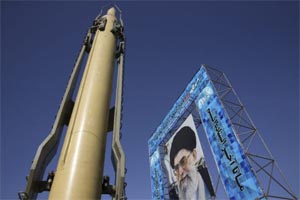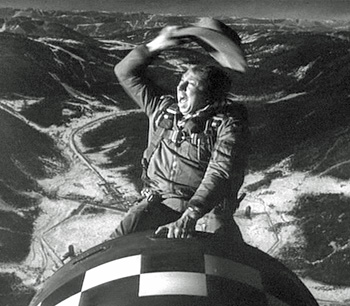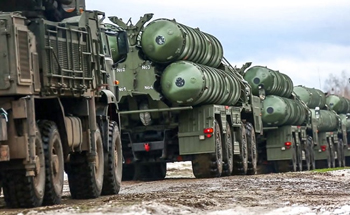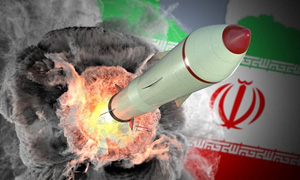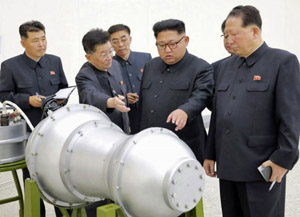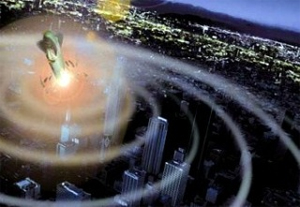Thinking About the “Unthinkable”
We are told: “Nuclear war cannot be won and must never be fought” which politically correct mantra is really believed by most in Washington, perhaps by most in America, even though it is patently false, evidences mass psychological “denial behavior” and is perilous to national security.[1]
Americans hate nuclear weapons, and those who think about them.[2] This I know from a professional lifetime as one who thinks about nuclear weapons, strategy, and warfare.
Philosophically, weapons of mass destruction are antithetical to the ethos of democratic societies deriving their legitimacy from the people, where government exists to serve the people, where the most precious jewel is the lives of the people. Nuclear weapons, that threaten mass destruction of the people, are so noxious in our society that almost no one wants to think about them—and very few do.
In contrast, totalitarian and authoritarian states are proud of their nuclear firepower and celebrate nuclear weapons. Russia, China, and North Korea parade nuclear missiles in their streets. They broadcast TV documentaries about winning nuclear wars, almost always against the United States.[3]
Military dictatorships and societies ruled by iron-fisted elites, where the dictators or their ideology is the most precious jewel, where the people are considered expendable—such societies love nuclear weapons. Even their peoples love The Bomb. They never seem to tire of nuclear missile parades and civil defense drills.
In totalitarian and authoritarian societies ruled by a “strongman” or ideological vanguard, nuclear arms are the “perfect weapon” for elites and peoples who believe in the omniscience and omnipotence of the state.
Refusing to think about nuclear weapons and warfare will not make the threat go away. Pretending to abolish nuclear weapons through arms control, as the West has been trying to do since 1945, is just another way of not thinking.[4]
We should have learned by now nuclear weapons are here to stay, a permanent fact of international life. The bad guys do not want to ban their bomb. They will encourage us to ban our bombs, but keep theirs.[5]
Pretending that nuclear strategy is Strangelovian, an evil necessity to be tolerated among a small group of closeted defense specialists—but not central to national security and real statesmanship—is yet another way of not thinking.
In fact, nuclear weapons are the most formidable military technology existing in the modern world. They are the most powerful piece on the geopolitical chess board.
Nuclear weapons are central to, and the foundation of, our national security.[6]
Nuclear Victory and Nuclear Defeat
The late great scholar strategist Colin S. Gray correctly observed, during the height of the Cold War, that nuclear weapons are so important they overshadow everything in war, peace, and diplomacy. Gray understood then, as we must now, that nuclear weapons are so powerful they shape the mental geography of international relations, and influence war, diplomacy, and peace—merely by existing.[7]
Thus, since 1945, every war fought involving a nuclear-armed power or their allies has been a nuclear war. All diplomacy involving nuclear-armed powers or their allies has been nuclear diplomacy. Since 1945, when there has been peace, it has been nuclear peace.
Since 1945, the greatest U.S. victories and greatest U.S. defeats have been nuclear victories, and nuclear defeats:
Nuclear victory looks like the 200,000 fatalities of Hiroshima and Nagasaki. But also like Japan surrendering on the deck of the USS Missouri, sparing over 1,000,000 fatalities expected from invading their home islands, and ending World War II.[8]
Nuclear victory looks like President Dwight Eisenhower threatening to use the U.S. advantage in tactical nuclear weapons to end the Korean War with an Armistice.[9]
Nuclear victory looks like President John F. Kennedy, armed with a 5-to-1 advantage in ICBMs, going eyeball to eyeball with Soviet Premier Nikita Khrushchev, forcing the USSR into a humiliating retreat during the Cuban missile crisis.[10]
Nuclear defeat looks like President Nixon’s retreat from South Vietnam. According to presidential advisor Rodger Swearingen, President Lyndon Johnson was afraid to invade, occupy, and liberate North Vietnam—the only way to win the conflict—fearing a nuclear war with China.[11]
Nuclear victory looks like deterring a Soviet invasion of Western Europe—despite the USSR’s vast numerical advantages in tanks, aircraft, artillery, and troops—and keeping the peace for 45 years.[12]
Nuclear victory looks like winning the Cold War with the disintegration of the Warsaw Pact and the collapse of the USSR without a thermonuclear World War III, defeating the most powerful totalitarian empire in history—peacefully.
Nuclear victory looks like successfully deterring Iraqi dictator Saddam Hussein from using chemical or biological weapons against U.S., allied troops, and Israel during the first Persian Gulf War (1990-1991).[13]
Nuclear defeat looks like Russia annexing the Crimea without firing a shot, torturing eastern Ukraine for 8 years to make mockery of Western security guarantees to Kyiv for giving up nuclear weapons, and rolling tanks across President Biden’s “line in the sand” to invade Ukraine.
Nuclear defeat looks like the West “fighting to the death of the last brave Ukrainian” and NATO refusing to impose a “no-fly zone” over Ukraine, even though the Russian Army appears to be on the ropes, from fear of Russian nuclear escalation.
Nuclear defeat looks like President Obama’s nuclear deal with Iran, and now President Biden’s quest for an even worse nuclear deal with Iran, entailing years of appeasing and empowering Iranian aggression and terrorism in the Middle East against U.S. allies Israel and moderate Arab states—so powerful is the shadow of Iran’s coming “Islamic Bomb.”[14]
Nuclear defeat looks like little North Korea being treated like a rival superpower—which they are because of nuclear weapons—while Pyongyang builds ICBMs that can range U.S. cities, orbits satellites over North America that may be armed for Super-EMP attack, and the U.S. does nothing.[15]
Nuclear defeat will look like a North Korean electromagnetic pulse (EMP) attack that blacks-out America and ends our civilization. Or terrorists vaporizing a city. Or Russia or China launching a nuclear Pearl Harbor against the U.S. to win a nuclear war.
These or other nuclear nightmares are more likely to happen if we do not think—and act.
Nuclear War Can Be Won
Another way of not thinking is to tell ourselves: “A nuclear war cannot be won and must never be fought.”
“Nuclear victory” is not only possible, but proven, as World War II was a nuclear war, fought and won by the United States. It should be obvious, even to anti-nuclear fanatics, that a nuclear war can be fought and won at least against any state that does not have nuclear weapons, which includes most of the nations of the world.[16]
Thus, were it not for the credibility of U.S. nuclear deterrence, the world would have been conquered by the forces of totalitarianism long ago.
It should also be obvious that a nuclear war can be won by a major nuclear power against a minor nuclear power. Were it not for U.S. nuclear deterrence, Russia could with near mathematical certainty make disarming nuclear strikes on nations such as Britain, France, and Israel—or destroy these allies completely.
Victory is also possible in a nuclear war between the superpowers.
A nuclear counterforce attack, most likely to be successful in a surprise first strike, with near mathematical certainty can so degrade the victim’s nuclear capabilities and command-control-communications-intelligence (C3I) that they cannot retaliate, or dare not retaliate from fear of exhausting forces needed to deter attacks on cities, or can only launch a weak and uncoordinated counterforce retaliatory strike.
In 1974, then Secretary of Defense James Schlesinger gave a classified Defense Department analysis to Congress Briefing on Counterforce Attacks (declassified and sanitized January 10, 1975) calculating a range of possible nuclear counterforce attacks by the USSR that would result in relatively low collateral civilian casualties (in the worst case 800,000 dead, 1.5 million total dead and injured, far less than 1% of the population) while successfully disarming the U.S.[17]
Today in 2022, Russian nuclear weapons are far more accurate, lower-yield, cleaner, there are new technologies specialized for surprise (like Super-EMP, hypersonic warheads, cyber weapons) and the U.S. counterforce target set is much smaller, so the technological threat of a nuclear Pearl Harbor looms much larger than in 1975.[18]
Today, Russian ICBMs/SLBMs/SLCMs have yield/accuracy combinations that would enable them to achieve over 90% single-shot-kill-probability against all U.S. strategic nuclear force targets—440 ICBM silos and launch control facilities, 3 bomber bases, two SSBN ports, NORAD HQ and other critical C3I nodes—with just 500 warheads. This would leave Moscow with at least 1,000 strategic warheads in reserve and 2,000-8,000 tactical nuclear warheads versus U.S. residual forces comprising some 320-540 warheads on SSBNs patrolling at sea.[19]
The surviving U.S. forces could be expended attacking empty Russian missile silos, vacant bomber and SSBN bases, impervious deep underground bunkers—leaving U.S. cities vulnerable. More likely, surviving U.S. nuclear forces would be held in reserve to deter attacks on cities.[20]
Such a counterforce attack, a nuclear Pearl Harbor, could be accomplished by just 50 Russian SS-18 Mod 5 ICBMs delivering 500 warheads, or just 50 of China’s DF-41 ICBMs delivering 500 warheads. U.S. casualties would probably be far less than those estimated by Schlesinger’s Defense Department in 1974. The U.S. would be disarmed and helpless to defend allies from conventional or nuclear aggression.[21]
This, too, is what nuclear victory could look like, for Russia and/or China.
Totalitarian versus Democratic Strategic Cultures
“Victory” also has political and cultural dimensions different for totalitarian states, incomprehensible and antithetical to the humanitarian ethos of Western democracies. Between 1930-1945, Russia sacrificed 50 million people, 20 million in purges and 30 million on the battlefields of World War II, to build and defend socialism, sacrifices celebrated and considered great victories by the USSR and Russia today.[22]
China, North Korea, and Iran have made similar sacrifices of their populations in war and peace to achieve the goals of their totalitarian states. Nuclear war may well be more “winnable” for totalitarian states than for Western democracies because totalitarians are much less averse to mega-deaths.[23]
Indeed, because of this disparity in strategic cultures, it is possible to imagine “nuclear victory” by small totalitarian powers, like North Korea or Iran, over the Western democracies, including the United States.
Imagine North Korea makes a Super-EMP attack that blacks-out North America for a year, resulting in starvation and societal collapse that kills 90% of Americans, while also nuclear blasting, invading and conquering South Korea.[24] U.S. nuclear retaliation might largely destroy North Korea’s armies, kill 90% of North Koreans, and leave both North and South Korea nuclear wastelands—but if Kim Jong-un is still alive and in control of what remains, he may well consider the outcome, the destruction of his enemies, though at terrible cost, a “victory.”
Imagine Iran buys Super-EMP weapons from North Korea, and uses these to destroy the electronic civilizations of the West, a nuclear suicide mission resulting in the total destruction of Iran. The radical Islamists who run Iran have indicated they are willing to sacrifice their nation and peoples in a holy war to achieve the triumph of Allah in the spiritual universe. Just as the 9/11 terrorists and frequent suicide bombers are considered by radical Islam to be “victorious”—so too their strategic culture would regard even the sacrifice of Iran in “jihad” against the West as “nuclear victory.”[25]
Alternatively, imagine Iran gets or already has nuclear weapons, and uses these in a “false flag” operation, perhaps in Ukraine, to provoke nuclear war between the “infidel” superpowers.[26] Victory by small nuclear states over great powers will become more imaginable in the New Nuclear Age where the bipolar world is gone, replaced by a nuclearized multi-polar New World Order.[27]
The risk of nuclear war, possible pathways to nuclear conflict, increases not merely incrementally—but exponentially—with every new addition to the roster of nuclear-armed states.
U.S. nuclear deterrence must dissuade totalitarian strategic cultures in Russia, China, North Korea, and Iran—aggressive evil actors willing to sacrifice millions of their people. U.S. nuclear deterrence is aimed at some of the worst dictators in world history, and of necessity will appear to be “excessive” and “overkill” to Western pacifists, anti-nuclear activists, and humanitarians who regard nuclear war as “unthinkable.”
We are trying to deter Vladimir Putin, Xi Jinping, and Kim Jong-un—not Mother Teresa.
Recommendations
President Biden’s stoking war in Ukraine is not a good idea. The Ukraine War could too easily escalate into losing a nuclear war with Russia. U.S. policy in Ukraine should seek a negotiated peace as soon as possible to end the war and its nuclear escalatory possibilities.
President Biden’s defunding of SLCM-N (Sea-Launched Cruise Missile Nuclear), over the protests of his own senior military leaders, is not a good idea. SLCM-N is the only realistic way to compensate somewhat for Russia’s vast preponderance in tactical nuclear weapons, favoring Moscow by at least 10-to-1.
The Biden Administration’s cancellation of the B-83 gravity bomb, at 1.2 megatons the most powerful U.S. nuclear weapon and the only remaining U.S. weapon of megaton-class, will cede to Russia overwhelming dominance in high-yield weapons. Russia’s Poseidon drone submarine alone has an advertised yield (probably adjustable) of 2-200 megatons. Most importantly, B-83 is the only U.S. nuclear weapon that has a chance to destroy deep underground shelters and hold at risk political-military elites of Russia, China, North Korea, and Iran. Arguably, this makes the B-83, antiquated and inadequate as it is, the single most important weapon in the U.S. inventory.
Banning U.S. ICBMs, or replacing the new Sentinel ICBM by trying to extend the life of the obsolete Minuteman III yet again, is a bad idea. Russia, China, and North Korea favor ICBMs because they are always ready to launch within a few minutes 24/7 and are ideally suited for surprise attack. U.S. ICBMs are “sentinels” against adversary surprise attack.
Banning U.S. strategic nuclear bombers, giving them all an exclusively conventional role, is a bad idea. Bombers, unlike missiles, can be recalled, and are the most flexible U.S. deterrent because they can carry a wide variety of arms.
Halving the planned buy of Columbia-class ballistic missile submarines from 12 to 6, and relying only on this diminished force for “Minimum Deterrence” in the hope that adversaries will follow our example, is a bad idea. The U.S. has already had a “nuclear deterrence holiday” with no modernization of weapons or delivery systems for 30 years—which Russia, China, and North Korea exploited by building-up modern nuclear arsenals.
The U.S. must greatly accelerate modernization of its nuclear Triad of ICBMs, SSBNs, and bombers—which are mostly or entirely not scheduled to arrive until the 2030s.
The U.S. must greatly accelerate re-building its defense scientific-industrial base for making nuclear weapons. The U.S. hopes to make 30 pits (the fission trigger for a thermonuclear weapon) annually in the 2030s. In contrast, today Russia can make 3,000 pits annually.
The U.S. must start making advanced technology nuclear weapons like those of Russia, China, and even North Korea, designed for Super-EMP and other specialized effects like x-rays and neutrons, variable yields including ultra-low-yields (1 kiloton and less). “New” U.S. nuclear weapons currently planned are merely more reliable versions of old designs, so the U.S. can continue to obey unilaterally the unratified Comprehensive Test Ban Treaty (violated by Russia and China).
The U.S. must launch a crash program to protect national electric grids and other life-sustaining critical infrastructures from EMP and Cyber Warfare. Nuclear deterrence will not work if adversaries can defeat the U.S. on the cheap through “Blackout Warfare.”
The U.S. should deploy space-based missile defenses, as envisioned in President Reagan’s Strategic Defense Initiative (SDI), to render nuclear missiles and nuclear warfare technologically obsolete. Former SDI Director, Ambassador Henry Cooper, estimates the U.S. could develop and deploy 1,000 Brilliant Pebbles space-based interceptors in 5 years for $20 billion.
Thus, by protecting American lives through hardening critical infrastructures and space-based defenses, we could replace Mutual Assured Destruction (MAD) with a new strategic principle more consistent with Judeo-Christian and humanist values, Strategic Assured National Existence (SANE), and maybe prevent—or win—a nuclear World War III.
About the author: Dr. Peter Vincent Pry is Executive Director of the Task Force on National and Homeland Security, served as Director of the U.S. Nuclear Strategy Forum, Chief of Staff of the Congressional EMP Commission, and on the staffs of the Congressional Strategic Posture Commission, House Armed Services Committee, and the CIA. He is author of the books Will America Be Protected?, Blackout Warfare, and The Power And The L
[1] When President Biden and Russia’s dictator Vladimir Putin met in Geneva in June 2021 and jointly declared “A nuclear war cannot be won and must never be fought” Putin must have known he would invade Ukraine the next year and threaten nuclear war against the West. Our adversaries know such propaganda will empower anti-nuclear activists in the West, while they prepare to fight and win nuclear wars.
[2] Popular discourse about nuclear weapons and strategy is overwhelmingly dominated by anti-nuclear groups like Union of Concerned Scientists, Federation of American Scientists, Ploughshares, Global Zero, Carnegie Foundation and their books and articles and journals like Bulletin of the Atomic Scientists, often quoted by a sympathetic press as an “objective expert view” more credible than the Defense Department.
[3] See for example: “North Korea Depicts Nuclear Attack On U.S.” Military.com (26 March 2016). “China Is Openly Discussing How To Nuke The U.S.” Businessinsider.com (11 November 2013). “Inside China: Nuclear Submarines Capable Of Widespread Attack On U.S.” Washington Times (31 October 2013).
[4] “The Case Against Arms Control” Real Clear Defense (24 June 2019). The still largely classified report by the White House General Advisory Committee on Arms Control and Disarmament, A Quarter Century of Soviet Compliance Practices Under Arms Control Commitments: 1958-1983 (October 1984) found the USSR in violation of most major arms control treaties. Subsequently, State Department annual compliance reports have found Russia in violation of most major arms control treaties, including the Intermediate-range Nuclear Forces Treaty, the Comprehensive Test Ban Treaty, and the Presidential Nuclear Initiative.
[5] Ibid.
[6] Acknowledged by the Department of Defense in every Nuclear Posture Review so far: 1994, 2002, 2010, and 2018.
[7] David Lonsdale, “Colin S. Gray: A Reminiscence” Warontherocks.com (22 June 2020). See some of Gray’s books: Strategy and History: Essays on Theory and Practice (2007); War, Peace and International Relations (2013); The Future of Strategy (2015); The Sheriff: America’s Defense of the New World Order (2021); The Geopolitics of Super Power (2021).
[8] Michael Peck, “Operation Downfall: 1,000,000 American Dead Invading Japan?” 1945 (15 October 2021).
[9] Dwight D. Eisenhower, Mandate For Change (1963). Sherman Adams, First Hand Report: The Story of the Eisenhower Administration (1961). Edward Keefer, “President Dwight D. Eisenhower and the End of the Korean War” Diplomatic History (Summer 1986).
[10] Royal Air Force Museum NationalColdWarExhibition/schools-colleges/national-curriculum/cuban-missile-crisis/us-advantage.aspx. Tom Ramos, From Berkeley To Berlin (2022).
[11] The late great Professor Rodger Swearingen, one of my mentors, during the 1960s established the USC Research Institute on Communist Strategy and Propaganda. According to Nina Tannenwald: “The most significant material constraint on using nuclear weapons was the risk of a wider war with China. U.S. leaders worried that a U.S. invasion of North Vietnam or the use of tactical nuclear weapons there could bring China into the war” The Nuclear Taboo: The United States and the Nonuse of Nuclear Weapons Since 1945 (Nautilus: 2003).
[12] See the annual Department of Defense report Soviet Military Power first published October 1981 and every year thereafter until collapse of the USSR in 1991.
[13] John Pike, “Nuclear Threats During the Gulf War” irp.fas.org (19 February 1998): “On 14 August 1991, Defense Secretary Cheney stated that ‘It should be clear to Saddam Hussein that we have a wide range of military capabilities that will let us respond with overwhelming force and extract a very high price should he be foolish enough to use chemical weapons on United States forces.’ The American government reportedly used third-party channels to privately warn Iraq that ‘in the event of a first use of a weapon of mass destruction by Iraq, the United States reserved the right to use any form of retaliation (presumably up to and including nuclear weapons).”
[14] Soeren Kern, “The Real Purpose Of The Iran Nuclear Deal” Gatestone (27 May 2022). Majid Rafizadeh, “Biden’s Legacy: A Nuclear Iran” Gatestone (22 December 2021).
[15] EMP Commission, Chairman’s Report (July 2017) www.firstempcommission.org. North Korea: EMP Threat (EMP Task Force: 6 June 2021) emptaskforce.us.
[16] Of the 195 nations in the world today (2022), only 9 have nuclear weapons: U.S., Russia, China, UK, France, India, Pakistan, Israel, and probably Iran.
[17] Secretary of Defense James R. Schlesinger, Hearing Before The Subcommittee On Arms Control, International Law And Organization, Committee On Foreign Relations, U.S. Senate, Briefing On Counterforce Attacks, 93rd Congress, 2nd Session, September 11, 1974 (Washington, D.C.: U.S. Government Printing Office, 1975) sanitized and declassified January 10, 1975.
[18] Dr. Peter Vincent Pry, Surprise Attack: ICBMs and the Real Nuclear Threat (EMP Task Force: 31 October 2020).
[19] Ibid. Dr. Peter Vincent Pry, What The Strategic Posture Commission Never Told You (White Paper 2010), see “Expert Warns: MAD Is No Longer Mutual” All News Pipeline (March 14, 2018).
[20] Ibid.
[21] Ibid. “China Will Probably Have 4,000 Nuclear Warheads By 2030” Center for Security Policy (18 November 2021).
[22] Robert Conquest, The Great Terror (1968) and Robert Conquest, The Great Terror: A Reassessment (1990).
[23] For example, during the decade of China’s self-inflicted “Cultural Revolution” (1966-1976) dictator Mao Zedong may have sacrificed more than 80 million and persecuted 125 million of his own people “building socialism.” Valerie Strauss and Daniel Southerl, “How Many Died? New Evidence Suggests Far Higher Numbers For The Victims Of Mao Zedong’s Era” Washington Post (17 July 1994): “While most scholars are reluctant to estimate the total number of ‘unnatural deaths’ in China under Mao, evidence shows he was in some way responsible for at least 40 million and perhaps 80 million or more.” Alternatively see World Peace Foundation, “China: The Cultural Revolution” sites.tufts.edu (14 December 2016): “Estimates of fatalities during the Cultural Revolution vary wildly—ranging between one million and 20 million.” On North Korea’s willingness to sacrifice its population, see Eli Fuhrman, “3.5 Million Dead: How North Korea Literally Starved To Death In The 1990s” National Interest (25 July 2021).
[24] On EMP Commission assessment that an EMP attack could blackout the U.S. for a year and kill up to 90% of the population from starvation see: Dr. William Graham, Ambassador R. James Woolsey, Dr. Peter Vincent Pry, “Prepare For The Worst” Real Clear Defense (21 October 2019). On North Korea’s capability to make a Super-EMP attack on the U.S. by satellite see: EMP Commission, Chairman’s Report (July 2017). North Korea: EMP Threat (EMP Task Force: 6 June 2021) emptaskforce.us.
[25] Iran: EMP Threat (EMP Task Force: 30 April 2022) emptaskforce.us.. “Iran’s Electromagnetic Pulse Attack Threat” Israel National News (10 May 2022).
[26] Iran already has nuclear weapons see Ibid and: Ambassador R. James Woolsey, Dr. William Graham, Ambassador Henry Cooper, Fritz Ermarth, Dr. Peter Vincent Pry, “Iran Probably Already Has The Bomb” National Review (19 March 2021).
[27] Paul Bracken, The Second Nuclear Age (2013).


